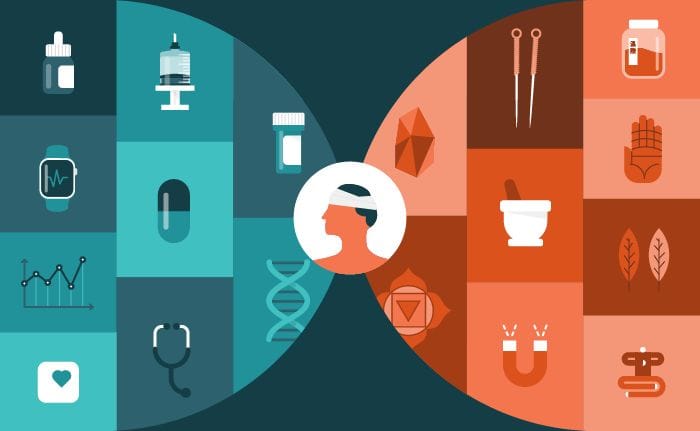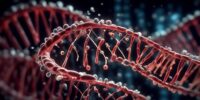Comparing Chinese Medicine And Functional Medicine: Holistic Approaches To Health

Chinese Medicine and Functional Medicine are two distinct holistic approaches to health that have gained popularity in recent years. Both systems share a common goal of treating the root causes of illness rather than just managing symptoms, and they emphasize the interconnectedness of the body, mind, and spirit.
Chinese Medicine, with its origins dating back thousands of years, is based on the concept of Qi (pronounced ‘chee’), an energy that flows through the body’s meridians. It employs diagnostic methods such as pulse diagnosis and tongue examination to identify imbalances in the body. Treatment modalities in Chinese Medicine include acupuncture, herbal medicine, and dietary therapy.
Functional Medicine, on the other hand, is a relatively newer approach that addresses the underlying causes of disease by looking at the interactions between genetic, environmental, and lifestyle factors. It utilizes diagnostic tools such as comprehensive lab testing and in-depth patient history to identify imbalances in the body’s systems. Treatment modalities in Functional Medicine may include personalized nutrition plans, lifestyle modifications, and targeted supplementation.
While Chinese Medicine and Functional Medicine share some similarities in their holistic approach to health, they also have notable differences in their origins, philosophies, and diagnostic methods. Understanding these similarities and differences can help individuals make informed decisions when seeking holistic healthcare options.
In this article, we will explore and compare the principles, diagnostic methods, and treatment modalities of Chinese Medicine and Functional Medicine, shedding light on the strengths and limitations of each approach.
Origins and Philosophies of Chinese Medicine
The origins and philosophies of Chinese Medicine can be traced back over 2,500 years and are rooted in the belief that the body is a complex system that can be brought into balance through the harmonization of opposing forces.
This holistic approach emphasizes the interdependence of mind, body, and environment in maintaining health. Chinese Medicine views the body as an interconnected network of meridians through which Qi, or vital energy, flows. The balance of Yin and Yang, complementary opposing forces, is crucial for optimal health.
Illness is seen as a result of imbalances or blockages in the flow of Qi. Chinese Medicine utilizes various modalities such as acupuncture, herbal medicine, diet, and exercise to restore balance and promote overall well-being.
The philosophy of Chinese Medicine continues to influence modern healthcare approaches, emphasizing the importance of addressing the root causes of health issues rather than merely treating symptoms.
Origins and Principles of Functional Medicine
Originating from a systems biology and patient-centered approach, functional medicine aims to address the underlying causes of disease by assessing the intricate interplay between genetics, environment, and lifestyle factors. It recognizes that each individual is unique and requires personalized treatment. The principles of functional medicine include understanding the web-like connections within the body, recognizing the importance of a balanced lifestyle, and promoting the body’s innate healing mechanisms. Functional medicine practitioners use a wide range of diagnostic tools, such as comprehensive health assessments, laboratory tests, and detailed patient histories, to gain a comprehensive understanding of each patient’s health. Treatment plans in functional medicine focus on holistic interventions, including nutrition, exercise, stress management, and targeted supplementation. By addressing the root causes and promoting overall health and well-being, functional medicine aims to optimize the body’s natural healing abilities.
| Principle of Functional Medicine |
|---|
| Individualization |
| Patient-centered care |
| Holistic approach |
| Address underlying causes |
| Promote overall health |
Diagnostic Methods in Chinese Medicine
This discussion will focus on the diagnostic methods used in Chinese Medicine, which include observation and questioning, pulse and tongue diagnosis, and the application of the Five-element theory and pattern identification.
Observation and questioning involves evaluating a patient’s physical appearance, behavior, and medical history to gather information about their health.
Pulse and tongue diagnosis is a unique diagnostic technique in which the practitioner assesses the quality and characteristics of the patient’s pulse and tongue to identify any imbalances or disharmonies in the body.
Lastly, the Five-element theory and pattern identification are used to analyze the patient’s symptoms and determine the underlying patterns of disharmony that may be causing their health issues.
Observation and questioning
Observation and questioning play crucial roles in both Chinese medicine and functional medicine, as they provide valuable insights into a patient’s health and guide the development of personalized treatment plans.
In Chinese medicine, observation involves examining various aspects of a patient’s appearance, such as their complexion, tongue, and pulse. These observations can provide information about the patient’s overall health, as well as specific imbalances or blockages in their body’s energy flow.
Questioning, on the other hand, involves gathering information about the patient’s symptoms, medical history, and lifestyle habits. This helps the Chinese medicine practitioner to gain a comprehensive understanding of the patient’s health condition and develop an appropriate treatment plan.
Similarly, in functional medicine, observation and questioning are used to gather information about the patient’s symptoms, medical history, and lifestyle factors. This allows the functional medicine practitioner to identify underlying imbalances or dysfunctions in the patient’s body and develop a personalized treatment plan that addresses the root causes of their health issues.
Overall, observation and questioning are fundamental diagnostic methods in both Chinese medicine and functional medicine, allowing practitioners to gain valuable insights into their patients’ health and provide holistic, personalized care.
Pulse and tongue diagnosis
Pulse and tongue diagnosis are diagnostic methods employed in both Chinese medicine and functional medicine to assess a patient’s health condition and identify underlying imbalances or dysfunctions.
In Chinese medicine, pulse diagnosis involves feeling the pulse at various points on the wrist to determine the quality, strength, and rhythm, which can provide information about the state of the organs and meridians.
Tongue diagnosis, on the other hand, involves examining the color, coating, shape, and moisture of the tongue, which can reveal the condition of the organs and overall health.
Similarly, functional medicine utilizes pulse and tongue diagnosis as part of a comprehensive assessment to identify patterns and imbalances in the body.
These diagnostic methods provide valuable insights into a patient’s health and help guide treatment strategies in both Chinese medicine and functional medicine approaches.
Five-element theory and pattern identification
Moving on from the previous subtopic of pulse and tongue diagnosis, we will now delve into the concept of Five-element theory and pattern identification in Chinese medicine and functional medicine. Five-element theory is an integral aspect of traditional Chinese medicine (TCM) and is based on the belief that the human body is interconnected with the natural elements of wood, fire, earth, metal, and water. This theory provides a framework for understanding the relationships between various organs, emotions, and bodily functions. Pattern identification, on the other hand, involves the analysis of symptoms and signs to determine the underlying imbalances within the body. In both Chinese medicine and functional medicine, pattern identification plays a crucial role in tailoring individualized treatment plans. The following table illustrates the associations between the five elements, organs, emotions, and bodily functions:
| Element | Organ | Emotion | Bodily Function |
|---|---|---|---|
| Wood | Liver | Anger | Smooth flow of qi and blood |
| Fire | Heart | Joy | Regulating circulation and consciousness |
| Earth | Spleen | Worry | Digestion and nutrient absorption |
| Metal | Lungs | Grief | Respiration and immune function |
| Water | Kidneys | Fear | Fluid balance and reproductive function |
By understanding and assessing these patterns, practitioners can target specific imbalances and promote overall health and well-being.
Diagnostic Methods in Functional Medicine
This discussion will focus on the diagnostic methods used in functional medicine, which includes a comprehensive patient history, laboratory testing and analysis, and the functional medicine matrix and systems approach.
The comprehensive patient history involves a thorough examination of the patient’s medical history, lifestyle factors, and environmental influences to identify potential underlying causes of health issues.
Laboratory testing and analysis are essential in functional medicine to assess various biomarkers and provide objective data for a more accurate diagnosis.
Lastly, the functional medicine matrix and systems approach takes into account the interconnectedness of different body systems and their impact on overall health, allowing for a more holistic and personalized approach to patient care.
Comprehensive patient history
In both Chinese medicine and functional medicine, a thorough and comprehensive patient history is considered essential in order to understand the individual’s health conditions and develop an appropriate treatment plan. This approach recognizes that health issues are multifaceted and interconnected, requiring a holistic understanding.
When taking a patient’s history, practitioners of both Chinese medicine and functional medicine pay attention to various aspects, including:
- Lifestyle factors
- Environmental exposures
- Dietary habits
- Emotional well-being
- Previous medical interventions
By gathering information on these different aspects, practitioners can identify patterns and potential underlying causes of health imbalances. This comprehensive patient history allows for a more personalized and targeted treatment approach, addressing the root causes rather than just managing symptoms. This emphasis on understanding the whole individual contributes to the holistic and patient-centered nature of both Chinese medicine and functional medicine.
Laboratory testing and analysis
Laboratory testing and analysis play a crucial role in both Chinese medicine and functional medicine, as they provide objective and quantitative data that can help practitioners assess the individual’s physiological functions and identify any underlying imbalances or dysfunctions.
In Chinese medicine, laboratory tests are used to complement the diagnostic methods based on observation, palpation, and questioning. These tests may include blood tests, urine analysis, and imaging studies, which can provide valuable information about the patient’s overall health status and the functioning of specific organs.
Functional medicine also heavily relies on laboratory testing to evaluate biomarkers and identify any imbalances or dysfunctions in the body. These tests may include blood tests, hormone panels, stool analysis, and genetic testing.
The results of these tests guide practitioners in developing personalized treatment plans that address the root causes of health issues and promote overall well-being.
Functional medicine matrix and systems approach
The functional medicine matrix and systems approach provides a comprehensive framework for understanding and addressing the interconnectedness of various physiological systems in the body. This approach recognizes that the body functions as a complex network of interrelated parts, and that a dysfunction in one system can have far-reaching effects on other systems.
The functional medicine matrix incorporates a thorough analysis of an individual’s health history, genetic predispositions, and environmental factors to identify the underlying causes of disease or imbalances. It views symptoms not as isolated occurrences, but as manifestations of underlying dysfunctions in the body. By addressing the root causes of these dysfunctions, functional medicine aims to restore balance and promote optimal health.
This approach emphasizes individualized treatment plans that target the specific needs of each patient, taking into account their unique genetic makeup and lifestyle factors.
Treatment Modalities in Chinese Medicine
Treatment modalities in Chinese medicine encompass a diverse array of techniques, such as acupuncture, herbal medicine, moxibustion, and cupping therapy, which are employed to restore balance and harmony within the body.
These modalities are based on the principles of Yin and Yang, Qi, and the five elements theory.
Acupuncture involves the insertion of fine needles into specific points along the body’s meridians to regulate the flow of Qi.
Herbal medicine utilizes various plant-based substances, such as roots, leaves, and flowers, to address imbalances and promote healing.
Moxibustion involves burning dried mugwort on or near specific acupuncture points to stimulate circulation and relieve pain.
Cupping therapy involves placing heated glass cups on the skin to create a vacuum, which helps to improve blood flow and alleviate muscle tension.
Treatment Modalities in Functional Medicine
Functional medicine offers a wide range of therapeutic modalities aimed at restoring optimal health and vitality by addressing the root causes of disease and promoting a personalized approach to patient care. Treatment modalities in functional medicine include:
- Nutrition: Functional medicine focuses on identifying and addressing any nutritional deficiencies or imbalances.
- Lifestyle modifications: This involves making changes in daily habits, such as improving sleep patterns, increasing physical activity, and reducing exposure to toxins.
- Supplementation: Supplements may be recommended to support specific bodily functions or address deficiencies.
- Detoxification: This aims to eliminate harmful toxins from the body through various methods, such as dietary changes and supporting the liver’s detoxification pathways.
- Stress management: Techniques like mindfulness, meditation, and relaxation exercises help reduce the negative impact of stress on overall health.
- Exercise: Seen as an essential component of functional medicine, exercise promotes physical fitness and enhances overall well-being.
- Mind-body techniques: Acupuncture, yoga, and tai chi are utilized to promote balance and harmony within the body.
Overall, functional medicine offers a comprehensive approach to healthcare, encompassing various treatment modalities to restore and maintain optimal health.
Similarities between Chinese Medicine and Functional Medicine
This discussion will explore the similarities between Chinese Medicine and Functional Medicine, focusing on three key points.
Firstly, both approaches share a holistic and patient-centered approach to healthcare, recognizing the interconnectedness of various body systems and the importance of addressing the whole person.
Secondly, both Chinese Medicine and Functional Medicine emphasize the importance of individualized treatment plans, tailoring interventions to meet each patient’s unique needs and circumstances.
Lastly, both modalities prioritize treating the root cause of health issues rather than simply alleviating symptoms, recognizing that true healing requires addressing the underlying imbalances or dysfunctions contributing to the presenting symptoms.
Holistic and patient-centered approach
A holistic and patient-centered approach to health focuses on addressing the individual as a whole, considering not only their physical symptoms but also their emotional, mental, and social well-being. Both Chinese Medicine and Functional Medicine share this common principle, aiming to treat the root cause of illness rather than just the symptoms. They prioritize the establishment of a therapeutic partnership between the practitioner and the patient, encouraging active participation in the healing process. This approach emphasizes the importance of personalized care, tailoring treatment plans to suit each individual’s unique needs. By considering various aspects of a person’s life, such as their diet, lifestyle, and environment, both Chinese Medicine and Functional Medicine strive to provide comprehensive and individualized care.
| Chinese Medicine | Functional Medicine | ||||||
|---|---|---|---|---|---|---|---|
| Focuses on balancing the body’s energy flow | Emphasizes identifying and addressing imbalances in the body’s biochemical processes | ||||||
| Utilizes acupuncture, herbal medicine, and dietary therapy | Utilizes advanced laboratory testing and nutritional supplements | ||||||
| Uses pulse and tongue diagnosis to assess imbalances | Uses comprehensive medical history and advanced diagnostic tools to identify underlying causes of illness | ||||||
| Considers the interplay between the body, mind, and environment | Considers the interconnectedness of various body systems and their impact on overall health | ||||||
| Aims to restore harmony and balance to the body | Aims to optimize physiological function and promote overall wellness | Focuses on prevention and treating the root causes of disease | Emphasizes the importance of lifestyle factors such as diet and exercise in maintaining health | Incorporates alternative and complementary therapies in addition to conventional medical treatments | Seeks to empower individuals to take an active role in their own healthcare | Recognizes the importance of emotional and mental well-being in overall health. |
Importance of individualized treatment plans
In the previous subtopic, we explored the holistic and patient-centered approach of both Chinese medicine and functional medicine. Now, let us delve into the importance of individualized treatment plans, which is a core aspect of these holistic approaches to health.
Both Chinese medicine and functional medicine recognize that each individual is unique, with their own set of physical, emotional, and environmental factors influencing their health. Therefore, a one-size-fits-all approach to treatment is ineffective. Instead, these approaches emphasize the need for individualized treatment plans tailored to the specific needs of each patient.
To achieve this, practitioners of Chinese medicine and functional medicine take into account a comprehensive range of factors, such as the patient’s medical history, lifestyle, diet, and emotional well-being. By doing so, they are able to develop personalized treatment plans that address the root causes of illness and promote optimal health and well-being.
Individualized treatment plans are essential in both Chinese medicine and functional medicine, as they recognize the unique nature of each individual and aim to provide targeted and holistic care.
- Recognition of individual uniqueness
- Tailoring treatment plans to specific needs
- Addressing root causes for optimal health.
Focus on treating the root cause of health issues
By prioritizing the identification and treatment of underlying causes of health issues, both Chinese and functional medicine strive to provide comprehensive and lasting solutions that can evoke a sense of empowerment and hope in patients. Chinese medicine, rooted in the principles of Yin and Yang, focuses on restoring balance and harmony within the body to address the root cause of illness. This approach emphasizes the interconnectedness of various bodily systems and aims to address the underlying imbalances that contribute to health issues. Functional medicine, on the other hand, utilizes a systems-oriented approach that investigates the interactions between genetic, environmental, and lifestyle factors to identify the root cause of health problems. By understanding the complex web of interconnected factors, functional medicine aims to create personalized treatment plans that address the underlying causes of illness rather than merely alleviating symptoms.
| Chinese Medicine | Functional Medicine | |
|---|---|---|
| Approach | Restoring balance and harmony | Systems-oriented investigation |
| Focus | Interconnectedness of bodily systems | Genetic, environmental, and lifestyle factors |
| Goal | Address underlying imbalances | Identify root cause of health problems |
| Treatment | Holistic and individualized | Personalized treatment plans |
Both Chinese and functional medicine prioritize treating the root cause of health issues instead of just managing symptoms. Chinese medicine focuses on restoring balance and harmony within the body, while functional medicine investigates the interactions between various factors to identify the underlying causes. By understanding the interconnectedness of bodily systems or the complex web of genetic, environmental, and lifestyle factors, these holistic approaches aim to provide comprehensive and lasting solutions for patients, promoting a sense of empowerment and hope.
Differences between Chinese Medicine and Functional Medicine
This discussion will focus on the key points of cultural and historical context, diagnostic methods and treatment modalities, and integration with conventional medicine and healthcare systems in order to highlight the differences between Chinese Medicine and Functional Medicine.
Understanding the cultural and historical context of these two approaches is crucial in order to appreciate their unique perspectives on health and well-being.
Additionally, their diagnostic methods and treatment modalities vary significantly, with Chinese Medicine relying on principles such as yin and yang and the five elements, while Functional Medicine utilizes a systems biology approach.
Finally, the integration of these approaches with conventional medicine and healthcare systems varies, with Chinese Medicine being more commonly integrated in Eastern countries, while Functional Medicine is gaining recognition in Western societies.
Cultural and historical context
Cultural and historical factors provide a rich backdrop for understanding the holistic approaches to health found in both Chinese medicine and functional medicine. Chinese medicine has its roots in ancient Chinese philosophy, particularly Taoism, which emphasizes the balance of yin and yang energies in the body. This concept is integral to the practice of Chinese medicine, where the goal is to restore balance and harmony to the body.
In contrast, functional medicine emerged in the late 20th century in response to the limitations of conventional medicine. It draws on a combination of scientific research and traditional healing practices from around the world. By considering the cultural and historical context of these approaches, we gain a deeper appreciation for their underlying principles and their potential to promote overall well-being.
Diagnostic methods and treatment modalities
One key aspect to consider when examining diagnostic methods and treatment modalities is the integration of scientific research with traditional healing practices in both Chinese medicine and functional medicine.
In Chinese medicine, diagnostic methods involve a combination of observation, questioning, and pulse and tongue examination. Treatment modalities in Chinese medicine include acupuncture, herbal medicine, and dietary therapy.
In functional medicine, diagnostic methods focus on identifying the root cause of the illness through comprehensive patient history, physical examination, and laboratory testing. Treatment modalities in functional medicine often involve personalized lifestyle changes, nutritional interventions, and targeted supplementation.
Both Chinese medicine and functional medicine emphasize the importance of individualized care and the promotion of self-healing. By blending traditional wisdom with scientific knowledge, these holistic approaches aim to restore balance and optimize health.
Integration with conventional medicine and healthcare systems
Integration with conventional medicine and healthcare systems involves the collaboration and incorporation of traditional healing practices from Chinese medicine and functional medicine into mainstream medical practices and healthcare policies.
This integration aims to provide a more comprehensive and holistic approach to patient care by combining the strengths of both systems. In some cases, Chinese medicine and functional medicine are used as complementary therapies alongside conventional treatments, such as acupuncture or herbal remedies being used alongside pharmaceutical interventions.
Additionally, healthcare systems may incorporate principles and philosophies from these holistic approaches into their policies and guidelines to promote a more patient-centered and personalized approach to healthcare.
This integration recognizes the potential benefits of traditional healing practices and seeks to bridge the gap between conventional medicine and alternative approaches for optimal patient outcomes.
Frequently Asked Questions
Are there any potential side effects or risks associated with Chinese medicine or functional medicine treatments?
Potential side effects and risks associated with Chinese medicine include allergic reactions, interactions with Western medications, and contamination of herbal products. Functional medicine may carry risks such as reliance on unproven treatments and delays in accessing conventional medical care.
Can Chinese medicine or functional medicine be used as a primary treatment for serious medical conditions, or is it more effective as a complementary therapy?
Chinese medicine and functional medicine can be used as primary treatments for serious medical conditions, although they are often more effective when used as complementary therapies alongside conventional medicine.
Are there any specific dietary or lifestyle recommendations that accompany Chinese medicine or functional medicine treatments?
Both Chinese medicine and functional medicine incorporate specific dietary and lifestyle recommendations as part of their treatments. These recommendations are tailored to the individual patient’s needs and aim to promote overall health and well-being.
How long does it typically take to see results from Chinese medicine or functional medicine treatments?
Typically, the time it takes to see results from Chinese medicine or functional medicine treatments varies depending on the individual’s condition and response to treatment. It is important to consult with a qualified practitioner for personalized advice.
Are there any specific training or certification requirements for practitioners of Chinese medicine or functional medicine?
Practitioners of Chinese medicine must complete a rigorous training program and pass a licensing exam to become certified. Functional medicine practitioners typically have a background in conventional medicine and may pursue additional certifications or training in functional medicine.








